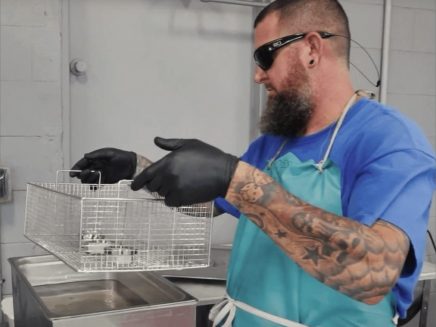Ultrasonic cleaning is a unique precision cleaning technology that removes contaminants that other techniques are unable to remove. The most exciting feature and the most significant benefit of ultrasonic cleaning is the removal of contaminants from inaccessible areas that are practically "out of sight."
Today, when surface geometry of many parts in different industries is measured in nanometers, sprays, solvents, or brushes cannot reach all surfaces of the part to be cleaned. That is why ultrasonic cleaning has a wide array of applications in various industries.
Ultrasonic cleaning effectively cleans:
- Automotive parts
- Aviation industry components
- Electronic equipment
- And much more
How Does Ultrasonic Cleaning Work?
Ultrasonic cleaning uses high-intensity and high-frequency sound waves to facilitate or amplify the removal of contaminants from a surface submerged in an ultrasonically activated cleaning solution. The frequency of these waves ranges from 30 to 80 kHz that agitate the liquid (cleaning solution) and clean the surface through a process called "cavitation."
These cavities are actually a lot of bubbles created by sound waves as these waves move through the cleaning solution. This formation of bubbles is known as cavitation, and the size of the bubbles depends upon the frequency of the sound waves.
Lower frequencies create large bubbles that explode more violently as compared to those produced at higher frequencies.
How Cavitation Helps Clean?
The bubbles are just empty spaces, and there's nothing to keep them intact. As a result, these bubbles collapse abruptly (as quickly as they are formed), sending "shockwaves" throughout the liquid.
This sudden implosion of bubbles creates tremendous vacuum energy in the form of heat and pressure. This combination of heat and pressure gives the ultrasonic waves their true cleaning ability and removes contaminants.
Duration and Efficiency
Typical cleaning time for ultrasonic cleaning ranges from 3 to 6 minutes; however, the overall duration depends entirely on the material being cleaned and the type of contamination. Delicate items and complex industrial parts may require even longer than 6 minutes.
Ultrasonic cleaning is very efficient in all cases and removes tightly adhered contaminants from the most intricate of items and inaccessible places like blind holes, recesses, and cracks. Typical pollutants removed by ultrasonic cleaning include oil, grease dust, dirt, fingerprints, pigments, flux agents, and polishing compounds.
The method is suitable for cleaning various materials, including glass, rubber, hard plastic, ceramics, and metals.
Required Assembly
A typical ultrasonic cleaning assembly features the following essential components:
- Tank – The tank carries the cleaning liquid and the items to be cleaned.
- Ultrasonic generator – This generator transforms AC electrical energy into ultrasonic waves.
- Ultrasonic transducer – The transducer converts the ultrasonic waves into mechanical energy that wipes off contamination.
Ultrasonic Cleaning Procedure
The ultrasonic tank or chamber is filled with a suitable cleaning fluid. The fluid is either water-based (aqueous) or solvent-based. Aqueous solutions contain wetting agents (surfactants) to reduce surface tension and increase cavitation. Aqueous solutions are generally less effective in cleaning but are environment-friendly as compared to solvent cleaning solutions.
The object (for cleaning) is placed in the tank, and the temperature of the cleaning liquid is elevated.
The transducer is already in place inside the tank to produce high-frequency ultrasonic waves. The frequency of these waves is maintained using an electric signal. The strength of these waves is stronger at the source of origin, but it is reduced a little as they move away from the transducer.
The waves enter into the fluid and create multiple millions of bubbles on their way. Once these bubbles (cavities) collapse, they release a tremendous amount of energy. The energy is sufficient enough to remove surface contamination and not damage the item itself.
Benefits of Ultrasonic Cleaning
Among limitless advantages of Ultrasonic, a few are:
- Cleans intricate parts without damaging
- Requires no manual effort
- Cleans inaccessible corners and blind holes
- It is environment-friendly and free of hazardous chemicals
- Cleans all types of contaminants efficiently, restoring equipment performance
Ultrasonic Cleaning Experts
Highly trained personnel at Precision Fabricating and Cleaning clean your filters and appliances and improve the overall efficiency of your equipment.
With 60 years of experience and advanced ultrasonic cleaning methods, we ensure the contamination goes away and your components are not damaged.
PFC performs ultrasonic cleaning services to the following specifications:
| 0-73579 | 1P00070 | 1P00071 |
| 24555-GEN-0001 | 24555-SPEC-0003 | 5-75014 |
| 5-75059 | 5-75192 | ARP1176 |
| ARP1176 | ARP598 | ARP599 |
| AS4059 | AS598 | ASTM D1193 |
| ASTM F312 | ASTM F331 | ASTM G93 |
| CGA 4.1 | IEST-STD-CC1246 | ISO 14644 |
| ISO 14952 | C-SPEC-C-20C | JSKSC-C-123 |
| MA0110-301 | MA0110-301 | MAP211025 VC |
| MIL-PRF-27401 | MIL-SPEC-164D | MIL-STD-1246 |
| MIL-STD-1246 | MSFC-SPEC-164 | NAVY OXYGEN CLEANER NOC |
| PWA 80-81 | RA0110-018 | RA0110-046 |
| RA0110-047 | RA0110-24 | RA1110-022 |
| RA1110-025 | RA1610-065 | RA1610-075 |
| RA321270 | RAPWA80 | RAPWASP80 |
| RPTSTD-8070-0001 | SAE ARP 598 | SAE ARP1176 |
| SN-C-0005 | STP0565 | STP0637 |
| STP1012 | RL10012 | D-0656395 |
| MC072214 | B185020 | STP 50408 |
| MP 50063 | AS 611 | ECSS-E-ST-35-06C |

